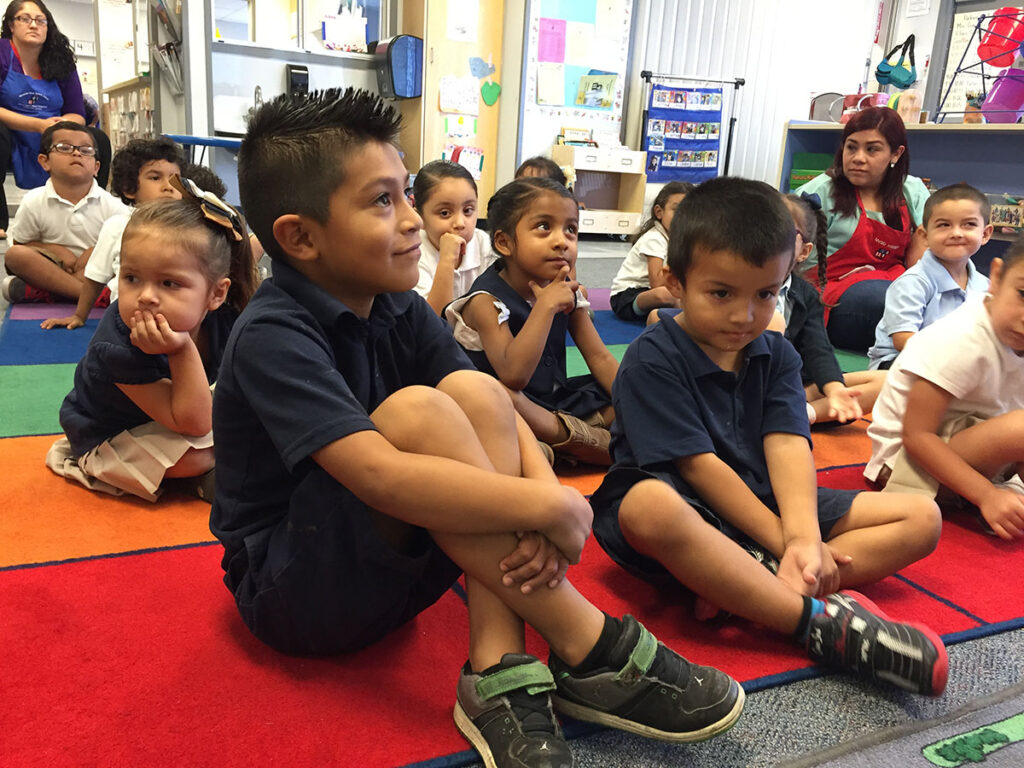


California currently faces a shortage of bilingual teachers. In this photo, students listen on during a during a Sobrato Early Academic Language (SEAL) class in El Monte in October 2015.
Sarah Tully, EdSourceWhat is Proposition 58?
Proposition 58, placed on the ballot by the state Legislature, was approved by voters with a 73.5 percent majority on Nov. 8, 2016. The proposition implements the California Multilingual Education Act of 2016, which was introduced in the Legislature by Sen. Ricardo Lara, D-Bell Gardens. A full legislative digest is available here.
What will the new law do?
The California Multilingual Education Act will give California public schools more control over dual language acquisition programs. Proposition 58 effectively repeals the English-only requirement of Proposition 227 — the initiative approved by voters in 1998 that requires English learners to be taught in English immersion classrooms. Under the new law, students can learn English through multiple programs outside of English immersion classes. The old law required parents to sign waivers to enroll their children in bilingual or dual immersion programs; the new law does not.
When does the new law go into effect?
The law goes into effect July 1, 2017.
Is every school and district required to create new programs?
It is not mandatory that school districts create new programs. Schools have the flexibility to design their own programs to suit the needs of both English learners and students already proficient in English who want to learn another language. However, the initiative requires that districts discuss plans for new programs with community members and parents and offer such programs “to the extent possible.” Specifically, the initiative says that if more than 20 parents or guardians from any one grade level or 30 parents or guardians from an entire school make a collective request for a dual language or bilingual program, the school site is required to at least explore the possibility of creating one.
How will districts be held accountable for changes resulting from the new law?
As part of the public engagement requirement of Proposition 58, school districts have to seek parent and community input when they create any new language acquisition program. This falls in line with the requirement of districts’ Local Control and Accountability Plans, in which input from an English Learner parent advisory committee is also required and responses must be noted in writing. The LCAPS are a central feature of the Local Control Funding Formula, California’s funding system that grants districts greater decision-making powers over how to use state funds, and gives them additional funds to serve high-needs students: low-income children, English learners, and foster children. The new law also requires that districts provide information on the types of language programs available in an annual notice to parents.
Were there schools with bilingual or dual language immersion programs before the passage of Prop. 58?
Yes. Many schools have either bilingual or dual language immersion programs that were established while Prop. 227 was in effect. But these were created if enough parents signed waiver requests specifically giving consent for their child to be enrolled in bilingual programs. According to a California Association for Bilingual Education and Californians Together press release issued in November, only 425 public schools currently offer dual immersion programs.
Will there be enough teachers to meet the need for additional bilingual education classes?
Finding teachers to staff additional bilingual classes will be challenging in light of a statewide teacher shortage, which has been especially acute in the field of bilingual instruction. In order to teach bilingual or dual immersion classes, teachers are expected to be proficient in both English and the non-English language they will be teaching, as well as have a bilingual authorization or credential. To offset teacher shortages, some schools pair teachers with proficiency in different languages. Using this approach, students may spend half of their day learning in English from one teacher who is proficient in English and the other half learning in a second language like Spanish or Cantonese from another teacher who is proficient in that language.
What languages are most in demand for bilingual education?
Spanish is by far the most common language spoken among California’s approximately 1.4 million English learners in the state’s public schools. It is spoken by 83.5 percent of those students, followed by 2.2 percent who speak Vietnamese and 1.5 percent who speak Mandarin, but the percentages of students with different language backgrounds will vary from district to district. (For a list of the top 10 languages spoken in California schools, go here.)